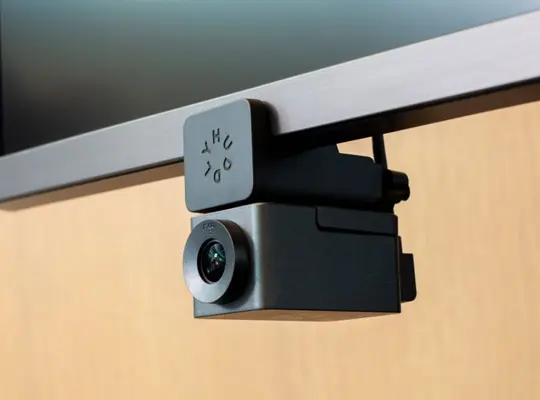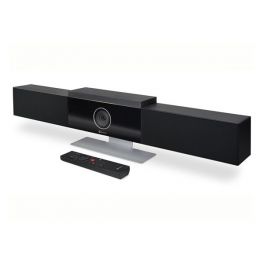
CHOOSING THE RIGHT EQUIPMENT CHAPTER 1: CAMERA AND VIDEO BAR
As you may have noticed, video calls are all the rage, and there's no end in sight! The choice of camera is essential. It may seem trivial at first, but choosing a too conventional camera means tempting the devil in terms of quality: inadequate field of view, overexposure, low definition image (blurred or choppy), etc.
So it is best to buy a device designed for meeting rooms. How to do it? Following this guide, which covers all the factors that must be taken into account when purchasing, starting with the most basic: ↓
CAMERA VS VIDEO BAR: HOW TO DISTINGUISH THEM?
Not to be confused with the webcam (see our dedicated page ), the camera/video bar is used for collaborative work. You may already know the name "video bar," but we bet you know very little about this device, starting with the difference between it and a camera.
So let's answer that famous question once and for all: what is the difference between a camera and a video bar?

Camera
As its name suggests, the camera is the video tool that allows your colleagues to see your every move. Until now, it was the essential element of meeting rooms. But now it shares the stage with the video bar.
Typically, it offers basic functions, such as:
- A high-resolution camera (usually HD or 4K)
- A wide field of vision
- Pan/tilt and zoom function (often referred to as PTZ)
It is worth knowing that not all conference camera models are equipped with microphones.

Video bar
In simple terms, a video bar is a long rectangular camera that is placed on a wall or near a screen (above or below). So much for aesthetics. If we get into the technical details, it is a kind of all-in-one video conferencing system.
Where it really stands out is in its features. Let me explain: unlike the camera (which sometimes lacks audio modules), the video bar ALWAYS contains the following elements in its housing:
- One ( or more ) camera(s)
- Speakers
- Microphones
Plus: some models work alone, using their own operating system. In short, you don't need your PC to use them!
THE ESSENTIAL VIDEO BARS
CHOOSING THE RIGHT MODEL: ESSENTIAL SELECTION CRITERIA
Don't make the mistake of choosing your video system on guesswork. There is a reason why the prices of cameras/camcorders vary by hundreds and even thousands of euros. Therefore, before choosing your model, we advise you to take into account the following criteria:
Resolution and frame rate:
Resolution
This is a fundamental criterion: it depends on (no less) the quality of the transmitted images! And better image quality means more non-verbal communication. Here's a quick summary of the resolutions you should choose if you don't want to appear "all blurry" on the screen:
- HD 720p : 1280 x 720 píxeles
- Full HD 1080p : 1920 x 1080 píxeles
- 4K UHD: 3840 x 2160 pixels
Frame rate:
The same thing happens with webcams: the higher the FPS, the smoother the transmitted images will be. Let's recap:
- 15 fps: the minimum for video conferencing!
- 30 fps: it is the most common in cameras (and the one that works for all occasions)!
- 60 fps: it is the best: natural video, smooth images and transfer of larger files - it's all possible!
Vision angle:
By definition, it is the area of a room that the camera can cover. Measured in degrees, it works as follows: the higher it is, the wider the visible radius. In detail, it works like this:
- 90°: Narrower, it is particularly appreciated in small rooms, because it puts everyone around the table in the spotlight.
- 120°/180°: They are the most used in cameras and video bars, simply because they adapt to all types of rooms (small, medium and large).
- 360°: Several sensors placed around the camera allow you to see the entire room. But for the magic to work, you have to place it on a table, not on the wall.
Note: some models are equipped with the "SmartFrame" and "SmartSpeaker" functions: automatic framing + speaker tracking (so that everyone is clearly visible)
PTZ functions:
In meetings with several people, they are the ones who make their encounters more natural (and therefore more human). How can they do it? Thanks to pan, tilt and zoom movements, which give greater depth to discussions, especially by focusing on active participants. The good thing is that this option is increasingly popular and is available in more and more models (especially the most recent ones), cameras and video bars included!
Microphone:
The microphone is the key to good communication. To be effective, you must be able to capture all voices at the table, and equally. Directional or omnidirectional, 180° or 360°, etc., there is no right or wrong choice: it all depends on your room configuration (size and layout). Just what you need, we have a page on the topic right here !
Pro tip: In large venues, we recommend adding extension microphones to ensure optimal audio coverage.
Placement:
Your camera or video bar may be equipped with the best viewing angle, but it still needs to be positioned correctly so that the result lives up to your expectations. Height, distance and angle: we have all the tips you need to correctly position your video system:
- It seems very simple, but to guarantee the visibility of all participants, the camera is placed at the end of the room.
- Do not place the camera in front of a window, otherwise backlighting is guaranteed.
- For a natural look, try placing the product at eye level (and if that's not possible, go straight for a PTZ model).
HOW DOES IT CONNECT TO THE SYSTEM?
Last but not least, when purchasing a video system you need to consider how you want to connect and use it. You have 3 options:
- Traditional video platform: It is the ideal option for medium and large spaces, as well as for specific installations!
- Proprietary solutions: These are pre-configured systems completely dedicated to a specific software package ( Teams , Zoom , Google Meet etc. )
- USB equipment: It is the most flexible alternative. You equip your room with equipment from different brands, and connect with your own PC!
To continue reading, click here: Choosing the right equipment act 2: the audio system
And to contact us, click here:










